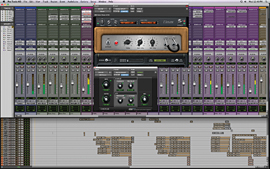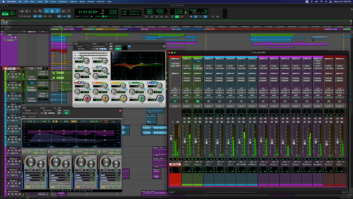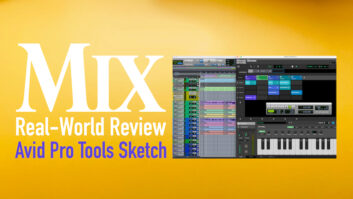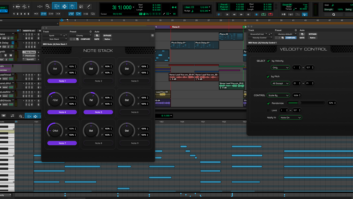
Pro Tools 8 offers many new features including 10 inserts, new plug-ins and instruments, and an enhanced GUI.
As a producer of urban, pop and dance music, I write and produce the MIDI for a song in Logic and then commit these tracks to audio and transfer to Pro Tools, where I add instruments and vocals, and go deep into editing. Using two programs is hardly ideal, so I jumped for joy when Digidesign announced this landmark upgrade.
Version 8 addresses many of Pro Tools’ long-running user concerns. An all-new MIDI Editor window finally brings world-class sequencing to the platform. Real-time audio pitching, a new Playlist view, track-comping tools and score editing are four more exciting treats. And engineers should delight in Pro Tools 8’s support for up to 10 inserts on any given track, plus automatic delay compensation on sends to handle mixer delays inherent in busing. Need more? There are dozens of new effects plug-ins and five new virtual instruments to hook you in.
Users of Digidesign’s ICON console, various Digi controllers and M-Audio peripherals will benefit from Pro Tools 8’s extended hardware control, which provides access to all 10 inserts and allows you to map plug-ins directly to the controller, address new soft-key commands and more. Also, the new Digidesign Satellite Link software option lets you chain up to five Pro Tools systems (or up to four Pro Tools systems and an Avid Media Composer or Video Satellite LE system) over Ethernet for scalable, nearly sample-accurate, synchronized processing. And a computer running Pro Tools LE can even be farmed out to act as a dedicated HD video playback source.
Hello New/Old Friend
Upgrading to Mac OS 10.5.5 (Leopard) was necessary to bring my dual-core PPC G5 with HD3 Accel hardware up to minimum system requirements. The full Pro Tools 8 upgrade file tipped in at just a little more than 4 GB, taking roughly two hours to download from the My Digi store. Installation atop V. 7 went flawlessly.
Pro Tools 8’s entirely redesigned GUI is both modern and extremely interactive. For example, a fully customizable toolbar in the Edit window lets you rearrange, show or hide the transport, zoom tools, MIDI and synchronization controls, and more. Buttons, LEDs, volume and pan knobs are redesigned in the Mix window. An improved color palette lets you color-in scribble strips as before, but also tints full channel strips in both the Mix and Edit windows. I found that adjusting the color saturation and brightness for channel strips was quite helpful for quickly identifying specific channel groups in very large sessions and for visually separating my MIDI sources between virtual instrument and outboard hardware coming in on aux inputs. Although indeed fresh, the GUI should feel quite familiar to current Pro Tools users.
Waveform overviews now have 16-bit (rather than the old 8-bit) visual clarity, providing better vertical resolution of the waveform when zoomed in for editing, especially on low signal-level recordings. Audio files up to 3.4 GB in size are supported (the old limit was 2 GB), allowing longer, single-file recordings. A new Plug-In and Mixer cache, for allocated DSP when you are closing and opening sessions, results in the ability to open/close all subsequent sessions much more quickly after launching Pro Tools, particularly with similarly configured sessions. The Playback Engine dialog also now provides hardware buffer size settings down to 64 samples for the lowest possible RTAS monitoring latency yet.
Closer to the Action
A common theme in this update is making Pro Tools’ workflow faster and more intuitive than ever. Universe View, for instance, provides an entire session overview by presenting audio, MIDI and video material as thin, colored horizontal lines. Clicking one of these region lines or framing a broader area within the Universe View instantly jumps to that set of foci in the Tracks pane of the Edit window.
Another example of simplified workflow is the new Playlist view, which allows alternate takes to be recorded and automatically displayed directly below the main track, each in its own lane — without losing the old recording. And soft-solo buttons for each Playlist lane can temporarily override the main take for easy auditioning. This new view is ideal for loop recording, and a new preference under Options lets you automatically create new playlists for each looped pass. Similarly, you can now view and edit multiple lanes of automation and MIDI controller data under a given track, regardless of the selected track view.
Track Compositing
Playlist view also serves as a nifty comping tool for quickly creating “perfect takes” from alternate tracks or from multiple passes captured in Loop Recording mode. You have a top-down representation of the recording history for a given track, where the last recorded take appears at the top in its own “main playlist” and all previous takes appear on their own sub-playlists. As you spot sections from the various takes that you want to comp together, simply make your selections and copy them to a new playlist. Alternately, you can use the Promote-Up function for lightning-fast comp edits.
A handy region rating system lets you rank each take on a scale of one to five. This simple feature saved me a considerable amount of time in noting my favorite passes during recording so that I’d be able to clarify my choices later. There’s even a smart solution for matching and comping alternate takes across multiple tracks, such as a drum kit. As long as each alt track has identical user time stamps, you can promote them all simultaneously within an edit region of your choice, thus keeping the multichannel image intact.
MIDI Editor View
Nowhere in this update is streamlined workflow more welcome than in the brilliant, new dedicated MIDI Editor. The archaic block methods of working with MIDI data are gone, replaced instead by a freely sizable and intuitive graphic piano-roll-style interface, complete with pencil and draw tools.
Within its main work area, notes can be displayed in varying shades of the assigned track color, with higher velocities appearing darker and lower velocities lighter. Notes can be inserted, deleted, moved, nudged, separated, consolidated (glued) and muted, either individually or as groups. You can also scrub/shuttle through MIDI parts, audition velocity changes and play MIDI notes when tabbing. Across the top of the Editor window is the requisite toolbar with MIDI Track Solo and Mute buttons, plus a standard Pro Tools complement of Trimmer, Insertion, Grabber, Pencil and Smart Tool buttons. Double-click at the bottom of the MIDI note editor, and you enter a split-pane mode to view/edit multiple MIDI parameters simultaneously, such as volume, pan, modulation, breath, etc. And you can have as many MIDI edit windows open as you like (i.e., one per instrument).
The Pro Tools MIDI Editor sets itself apart from all others by letting you simultaneously view the contents of multiple MIDI tracks at a time, superimposing the note data from various instruments in their own unique colors. This can become cluttered and hard to work with, but wherever note data from multiple instruments resides within the same area and obscures the view, you can selectively hide certain instruments’ note data, with their notes continuing to play back.
I really love this completely different perspective of MIDI tracks. You can tweak individual MIDI elements or “nip and tuck” the entire arrangement as new ideas hit you. And by using the up/down arrow keys, you can quickly switch from one virtual instrument or outboard MIDI track to another and record, edit and play back in one fluid pass or looped scenario.
That said, I’d love having some real-time MIDI macros or performance-oriented tasks. Something similar to the Transform window found in Logic would be cool, where mathematical variables and Boolean statements could be used to generate crescendos and arpeggios, perform MIDI routing and controller conversion tricks, and more.
As an aside, Pro Tools’s four edit modes (Shuffle, Slip, Spot and Grid) had been mutually exclusive. But now you can snap-to-grid while in any of the other three. For example, in Shuffle mode and with Grid enabled, you can make a selection in a region based on the grid and cut the selection, and any regions to the right of the edit will shuffle to the left. This is incredibly handy in loop-based music for slicing to the downbeat, no matter the groove.
Elastic Pitch
The Elastic Properties window now has transposition settings for desired amounts over a ±2-octave range. However, Elastic Pitch must be applied to regions in full, so altering single notes or parts of a region requires creating smaller regions. This is apparently due to the fact that Elastic Pitch transposition is supported with the Polyphonic, Rhythmic and X-Form algorithms only, but not Monophonic.
The upswing is that you can now transpose audio in real time, just like MIDI, and pitching quality is quite good and transparent. Eventually, perhaps Digidesign will take this more in the direction of Celemony Melodyne. These days, pitching has come of age to where you expect much more selectivity over individual notes and the ability to draw in vibrato curves or other articulations.
Way to Score
Digidesign’s acquisition of Sibelius has paid off big in Pro Tools 8. Along with its extremely reliable and accurate transcription of MIDI in real time, the new Score Editor also lets composers “write” music into Pro Tools as never before. Whether you record, import, draw in with the pencil tool or Step Enter MIDI, the Score Editor transcribes MIDI notes as they’re played or entered, and any changes are immediately audible. You can choose to edit within a full scoring window or have the editor follow the selections you make in the main Edit window. In fact, activities can be linked between the main Edit, MIDI Editor and MIDI Event List windows at all times.
To provide only certain parts of a large arrangement to session players, I could quickly pick and choose individual MIDI and instrument tracks from the tracklist. Once the tracks were added to my score sheet, I began fine-tuning appearance through global and independent track attributes. These include setting the clef; adjusting display quantization, with options to straighten swing and allow note overlap; and determining whether to display the track at “concert pitch” or as a transposing instrument, such as a B-flat tenor sax. I was dismayed that no freely assignable text placement or lyrical support is given.
For an integrated solution, score editing is quite flexible. You can select, transpose, move, insert and delete notes; change keys and meters; and insert chord symbols and diagrams. The Chord Change dialog lets you specify chord diagrams (guitar tablatures) for placement on the score. Here, you can select the chord, chord quality and bass note of the chord.
When it comes time to print, the Score Setup window lets you enter information such as the title and composer of the score; whether attributes such as page and bar numbers are displayed; the spacing between staves, systems and chord symbol/diagrams; and basic page layout parameters such as whether to print portrait or landscape and with what margin sizes. Beyond any of this, you’ll likely need to make use of the Export .sib files option (Sibelius 5 or higher required) for deeper notation editing and cosmetic touch-ups there.
I’m a One-DAW Man
Pro Tools 8 has proven to be an inspiring, exciting and highly creative work environment. Finally, it’s everything that I need to complete a project from start to finish. I’d like to see expanded Elastic Pitch facilities, along with macro programming and real-time performance-oriented routines brought to MIDI. The Score Editor is a welcome addition but remains quite utilitarian, generating quick score displays and printouts with few frills and no lyrical support.
Most impressive is how Pro Tools 8 has finally become the “everything” DAW. The MIDI Editor not only brings Pro Tools 8 current with competing software packages, but even surpasses them in terms of the groundbreaking interface. As a songwriter, I find the ability to work with MIDI in the same way that you imagine music — as a malleable cloud of instruments and notes interacting within your head — to be nothing short of miraculous. For me, that’s always been the missing link in Pro Tools — but not any more.
Jason Scott Alexander is a producer/mixer/remixer in Ottawa, Canada.

A.I.R. PLUGS EXPOSED
Until now, Digidesign has not included virtual instruments with Pro Tools. Upping the ante on its competition in this area as well, Pro Tools 8 comes with an impressive bounty of new instruments and effects plug-ins that are free. The A.I.R. “Creative Collection” gives you a hot new electronic rhythm module called Boom — whose look, feel and sound are inspired by classic analog and digital drum machines — plus a killer-sounding tonewheel organ module called DB-33, complete with full drawbar functionality and several tonewheel models for a wide range of classic organ sounds. DB-33’s integrated convolution-based rotary speaker cabinet and tube preamp emulations are also available as independent effects plug-ins, and they do sound pretty awesome!
Also bundled is Mini Grand, an acoustic piano module with seven selectable models (Atmospheric, Soft, Ballad, Real, Bright, Hard and Dance) and eight velocity layers per key. Though it sounds great in a mix, when solo’ed it expectedly fell short of reproducing the subtleties afforded by the best 100-plus-GB libraries out there.
Structure Free is a scaled-down version of Digidesign’s acclaimed sampler, while Xpand!2 comes with 1.5 Gigabytes of amazing new content on disc. The funkiest plug-in, though, is Vacuum. With its dusty and distressed looking front panel, this unique-sounding, dual-oscillator analog-modeling affair employs a form of synthesis based on valve emulation at the oscillator drive, mixer drive, highpass and lowpass filter saturation, and output tube amp stages. It delivers a distinctly rich and lush tone on leads, basses and pads, and can generate some pretty squirrelly special effects.
— Jason Scott Alexander







